- 24H Open Interest$122,903,101,952.36-3.00%
- 24h Liquidation$354,779,892.230%
- 24h long/short Ratio48.79% / 51.21%
- Fear & Greed Index22
- Bitcoin Price$89,523.7-1.9%
- Ethereum Price$3,028.71-3.28%
- Solana Price$132.49-3.21%
- XRP Price$2.02-2.02%
- 24H Open Interest$122,903,101,952.36-3.00%
- 24h Liquidation$354,779,892.230%
- 24h long/short Ratio48.79% / 51.21%
- Fear & Greed Index22
- Bitcoin Price$89,523.7-1.9%
- Ethereum Price$3,028.71-3.28%
- Solana Price$132.49-3.21%
- XRP Price$2.02-2.02%
Crypto Perps vs Spot Trading Explained
Learn how crypto spot and perpetual trading differ, explore risks, fees, and leverage, and find out which method fits your trading style and investment goals.
Key Takeaways:
- Ownership vs. Speculation: Spot trading gives you direct ownership of crypto and its utility, while perpetual contracts allow price speculation without owning the asset.
- Risk and Leverage: Spot trading limits losses to your invested capital with no liquidation risk, whereas perps offer high leverage, increasing both potential gains and the risk of liquidation and funding fees.
- Use Cases and Strategy: Spot is ideal for long-term holding and simpler strategies, while perps cater to short-term speculation, hedging, and active trading, requiring more experience and risk management.
Crypto trading comes in two main forms: spot trading and perpetual contracts. If you’re new to crypto, think of spot trading as buying and owning a physical product (e.g. gold). You hold it, use it, and keep it as long as you want.
Perpetual contracts, on the other hand, are more like betting on whether the gold's price will go up or down without owning it. This lets you control a larger position with less capital but also increases the risks.
This article breaks down these concepts in simple terms, explains the key differences, and shows when each method might fit your personal trading goals and comfort level.
What are Crypto Perpetual (Perps) Contracts?
Perpetual contracts (or perpetual futures, often just called perps) are a type of crypto derivative that lets you speculate on an asset’s price without owning it. Perps were first popularized by BitMEX in 2016, which invented the “perpetual swap” concept, and they have since become the most traded instruments in crypto.
A perp’s price closely tracks the underlying spot price through a mechanism called the funding rate: when the perp price is above spot, longs pay shorts; when below, shorts pay longs. This continuous funding causes the perp price to oscillate around the spot price, effectively anchoring it.
Unlike quarterly futures that converge to spot at expiry, perps use funding payments to continuously converge since they never expire. Given these features, perps are powerful but complex, and most retail traders lose money (97% of day traders lose within 300 days), making perps unforgiving without skill and preparation.
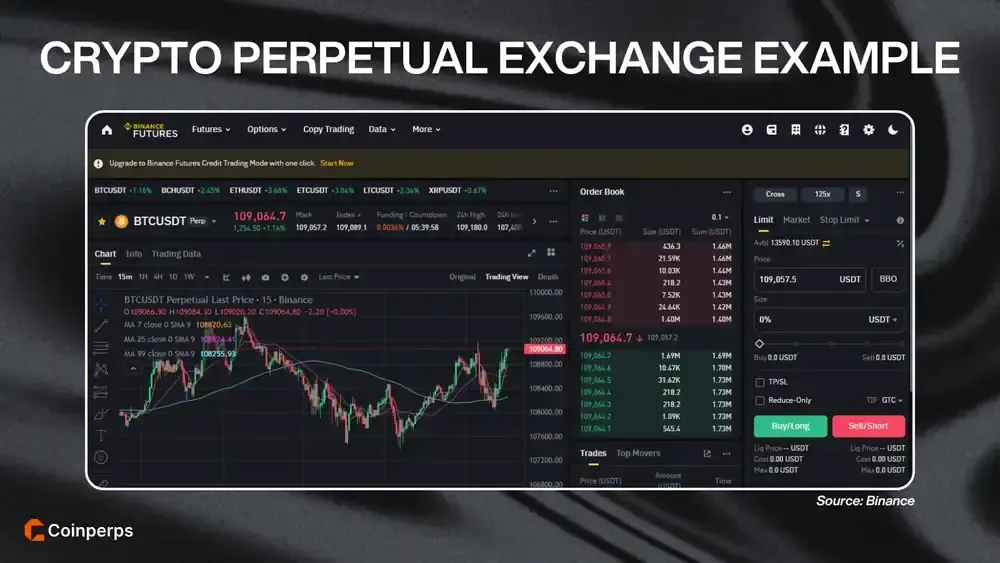
What is Crypto Spot Trading?
Crypto spot trading refers to the direct purchase or sale of digital assets for immediate delivery and ownership. Whether you're swapping ETH for USDC on Coinbase or using a DEX like Uniswap, the key principle is the same: you walk away owning the actual asset, not a contract.
Because you're holding the real token, not a synthetic position, you’re exposed to the asset's full utility and long-term price movement. This means you can transfer it to cold storage, stake it, use it as collateral in DeFi, or simply hold and wait, a level of flexibility that perpetuals and other derivatives don’t offer.
By default, spot trading involves no leverage, as you trade only with the funds you have, making it simpler and lower risk for beginners. Our observation shows that most newcomers start with spot to understand market movements, while long-term investors use spot trading to accumulate assets and take profits over time.
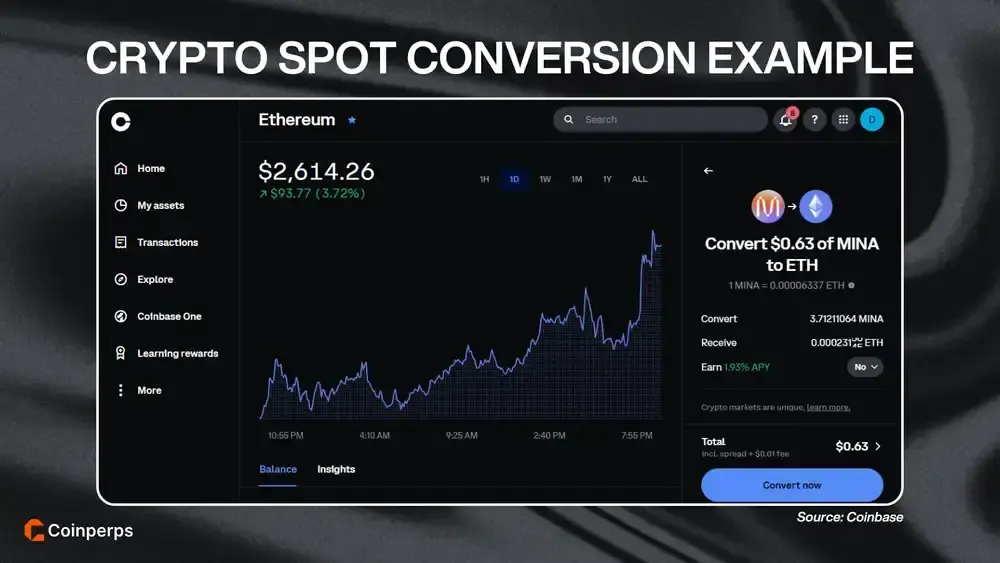
Differences Between Perpetual and Spot Trading
At a high level, the difference between perps and spot trading is simple: with spot, you own the asset outright, while perpetual contracts let you bet on price fluctuations without owning it.
Now, let’s break down the finer details:
- Ownership of Assets: Spot trading gives you direct ownership of the cryptocurrency you buy, while perpetual contracts are derivatives and don’t grant ownership of the underlying asset.
- Leverage Availability: Spot trading is typically unleveraged (1:1), whereas perps often offer high leverage, sometimes up to 500x (on MEXC for example), amplifying both gains and losses.
- Long/Short Direction: Spot trading only profits from price increases (going long), but perps allow you to easily go long or short and profit from price moves in either direction.
- Settlement & Expiry: Spot trades settle instantly with no expiry, and you can hold assets indefinitely; perps have no fixed expiry but require ongoing funding payments and margin maintenance.
- Funding Fees vs Exchange Fees: Spot traders pay only trading fees, while perp traders pay trading fees plus periodic funding fees exchanged between longs and shorts to keep prices aligned.
- Risk of Liquidation: Spot trading has no liquidation risk; your losses are limited to your investment, while perps carry liquidation risk due to leverage and margin requirements.
- Use Cases & Strategy: Spot is suited for long-term investing and simpler strategies, while perps are favored for short-term speculation, hedging, and active trading by experienced users.
Fee Structures in Spot vs Perpetual Trading
Fees directly impact your profitability, so it’s important to understand how costs differ between spot and perp trading. On a broad scale, spot trading fees are typically straightforward: a tiny percentage of each trade (paid as a commission to the exchange or DEX).
Similar to trading commissions, perpetual trading fees also include funding fees that traders exchange with one another and, depending on the platform, additional expenses like settlement or borrowing fees.
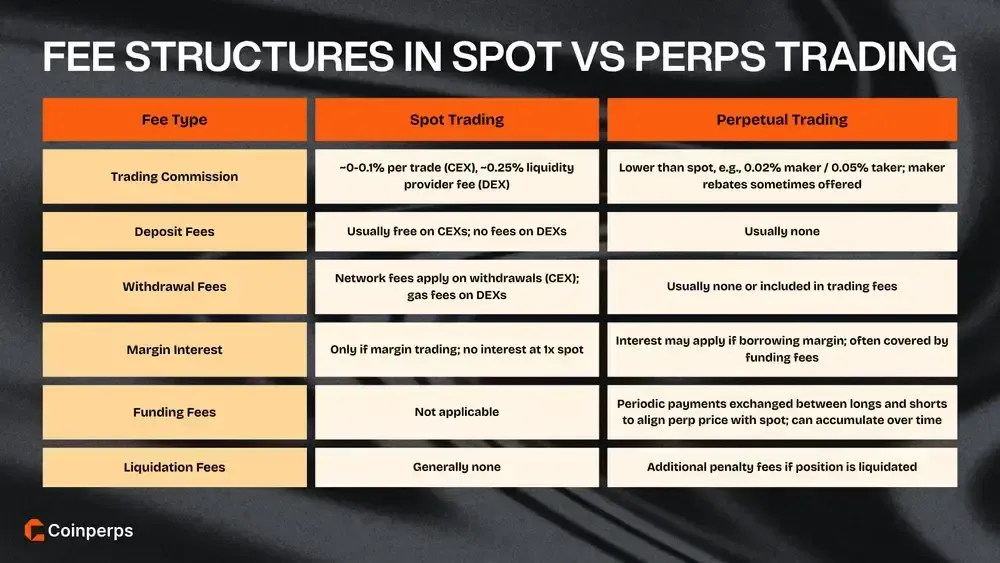
Fees in Spot Trading
Spot trading fees are generally simple and transparent, focusing mainly on trading commissions and occasional network costs. Key characteristics include:
- Trading Commission (Maker/Taker Fees): Centralized exchanges charge a small percentage per trade, typically around 0.1%. DEXs impose liquidity provider fees (e.g., PancakeSwap charges ~0.25%).
- Deposit/Withdrawal Fees: Deposits on CEXs are usually free; withdrawals incur network fees. On DEXs, no deposit/withdraw fees exist, but users pay on-chain gas fees.
- Margin Interest: Only applicable if margin trading; otherwise, spot trading at 1x has no interest costs.
- Spread/Slippage: Not a formal fee but an implicit cost when market orders move price due to liquidity.
Example: Buying 1 ETH at $1,800 with a 0.1% fee costs $1.80 in fees; holding incurs no further costs.
Fees in Perpetual Trading
Perpetual contracts have a more complex fee structure, combining trading commissions with ongoing funding and margin-related costs. The most important things are:
- Trading Fees (Maker/Taker): Usually lower than spot fees, often around 0.02% maker / 0.05% taker on major exchanges like Binance. Some platforms offer maker rebates.
- Funding Fees: Periodic payments exchanged between longs and shorts to keep perp prices close to spot. Funding rates vary and can add up immensely over time.
- Settlement or Delivery Fees: Usually negligible or included in trading fees since perps don’t expire.
- Margin-related Costs: Interest may apply if borrowing margin, but most perp positions use own collateral with funding covering costs.
- Liquidation Fees: Additional penalty fees may apply if your position is liquidated.
Example: A 10x leveraged 1 BTC perp position opened and closed in one day might pay about $22 in fees (trading plus funding). Holding longer can increase funding costs substantially.
Crypto Perps Leverage vs Spot Trading Margin
Perpetual exchanges let you quickly adjust leverage to amplify your exposure, like turning $1,000 into a $10,000 position without borrowing assets directly. They provide clear liquidation prices and simple shorting, but traders face recurring funding fees and heightened risk from high leverage that can rapidly erode profits.
Spot margin trading requires borrowing assets to increase buying power, which means paying interest and managing loans carefully. Leverage is generally capped lower, shorting is limited to certain coins, and liquidations can be complex, sometimes involving partial sell-offs or using other assets to cover losses.
Perpetuals vs Spot Trading in DeFi
Spot trading on decentralized exchanges like Raydium lets you swap tokens directly from your wallet using liquidity pools, with no intermediaries or custody of your funds. While this setup ensures control and privacy, trades can face higher slippage and network fees, and leverage isn’t available without borrowing through separate lending protocols.
Perpetual DEXes such as Hyperliquid and dYdX enable leveraged, futures trading using either on-chain order books or AMM liquidity pools with price oracles. These platforms offer decentralized benefits like no KYC trading and self-custody but come with funding fees, protocol risks, and sometimes wider spreads, though liquidity and user experience are steadily improving.
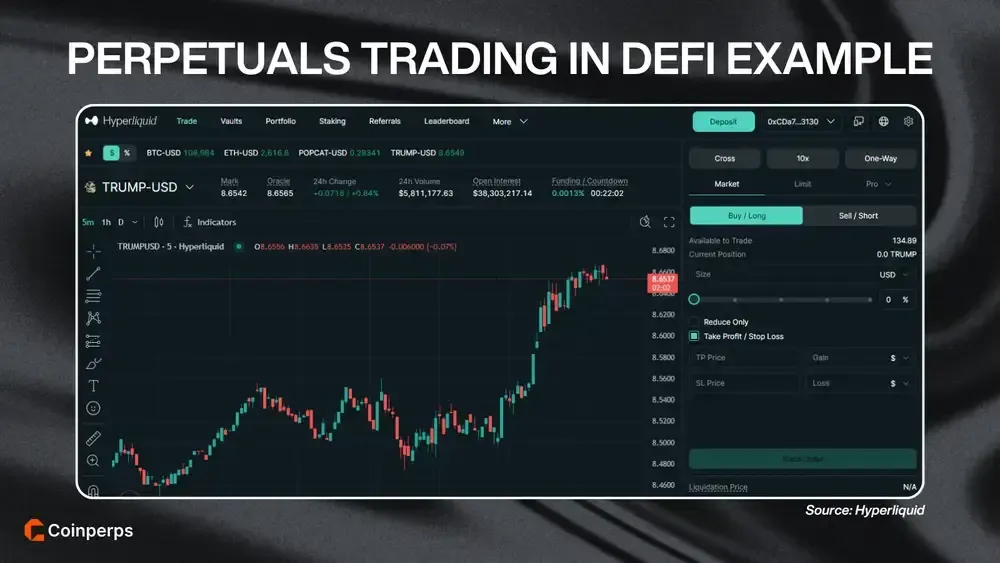
Perpetual vs Spot Trading Risks
Trading crypto always involves risk, but perpetual contracts carry additional complexities and dangers due to leverage and platform factors. Spot trading is simpler mechanically but still exposes you to market volatility and custody concerns.
Risks in Perpetual Trading
Perpetual trading introduces risks tied to leverage, funding costs, and platform stability, requiring active management and discipline. Key risks include:
- Liquidation Risk: If your position approaches a margin limit, exchanges can forcibly liquidate your trade immediately, often at unfavorable prices, wiping out your invested capital rapidly.
- Amplified Losses: Using leverage magnifies both gains and losses, meaning a small adverse price move can result in disproportionately large financial damage to your account.
- Funding Fees: These are periodic payments exchanged between longs and shorts to keep perpetual prices aligned with spot; continuous funding payments can erode profits, especially on long-term holdings.
- Price Volatility & Manipulation: Crypto markets can experience sudden, extreme price swings or manipulative tactics like “stop hunts,” which may trigger unexpected liquidations or margin calls.
- Psychological Stress: The fast pace and leverage of perpetual trading can cause emotional decision-making, such as impulsive trades or “revenge trading,” which often leads to greater losses.
- Platform Risk: Holding collateral on exchanges exposes you to risks like hacks, insolvency, withdrawal freezes, or smart contract vulnerabilities in decentralized platforms, potentially leading to loss of funds.
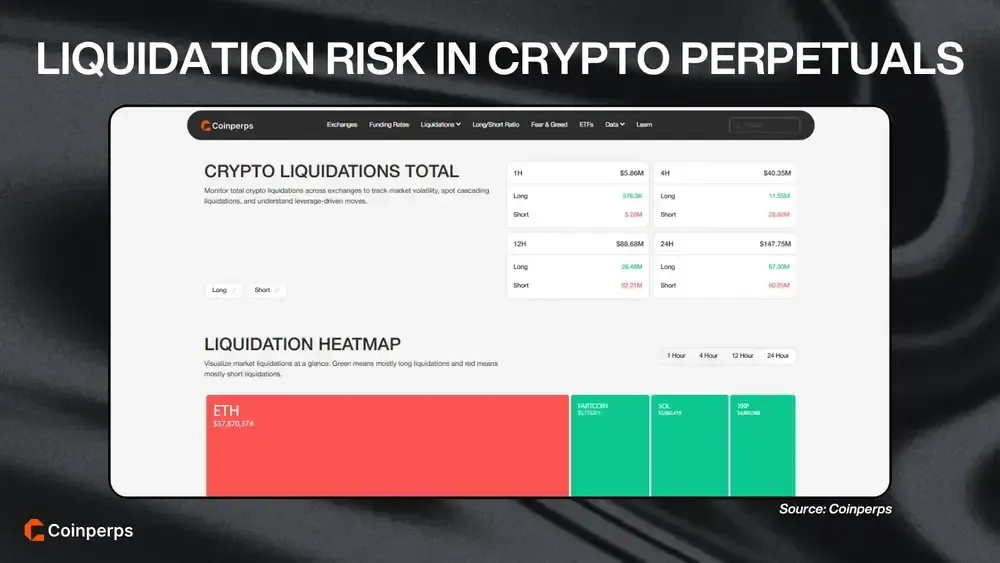
Risks in Spot Trading
Spot trading lacks leverage but still involves market risk and custody vulnerabilities. While simpler, it requires patience and careful asset selection to avoid large losses. Main risks include:
- Market Volatility: Crypto prices can plummet sharply, causing significant losses; however, unlike perps, there’s no forced liquidation, so losses depend on how long you hold or when you decide to sell.
- Permanent Loss: Some cryptocurrencies or tokens may fail or become worthless over time, resulting in a total loss of your investment if you don’t exit early enough.
- Custodial Risk: If you keep funds on centralized exchanges, you face risks of hacks, insolvencies, or restrictions on withdrawals, which can lock your assets or cause losses.
- No Hedging Tools: Spot trading doesn’t allow easy short selling or use of leverage, limiting your ability to hedge against market downturns or amplify gains.
- Liquidity & Slippage: Large trades or trading low-volume coins can lead to severe price impact and slippage, resulting in worse execution prices than expected.
- Operational Risk: Losing private keys, sending funds to the wrong address, or mistakes in transactions are irreversible and can lead to permanent loss of your crypto assets.
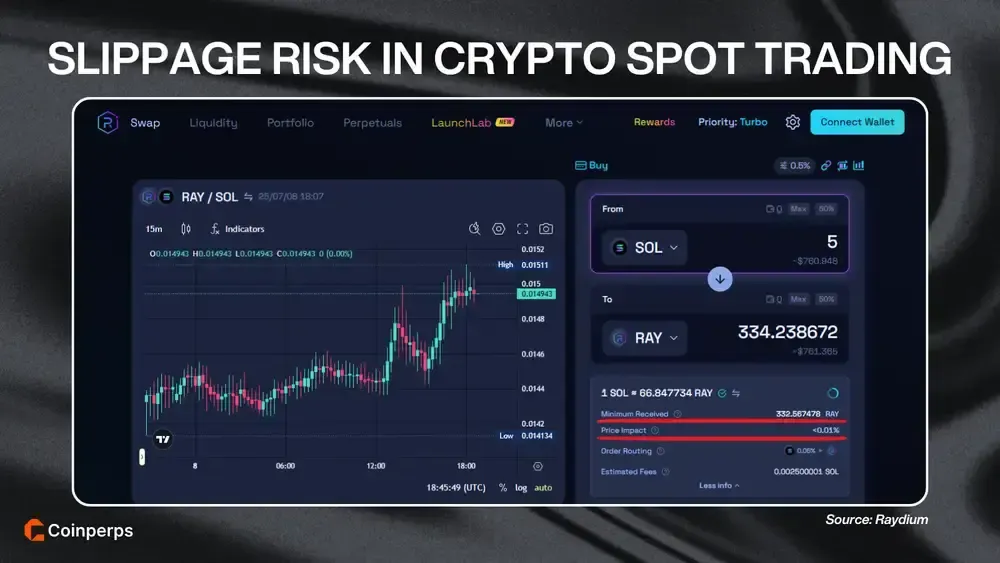
Tax Implications for Traders With Spot and Perps
Taxation on spot trading typically occurs when you sell or swap cryptocurrencies, triggering capital gains or losses based on how long you held the asset, with some jurisdictions offering favorable rates for long-term holdings (for example, the USA, Canada, and the UK. have such provisions).
Perpetual contracts, treated as derivatives, may have different tax rules, such as the U.S. 60/40 tax treatment for regulated futures, though many crypto perps are taxed like short-term gains, and funding fees usually factor into your overall profit and loss.
Both spot and perpetual trading require careful record-keeping due to frequent transactions and complex regulations. Many traders use crypto tax software like CoinTracker or Koinly to manage their records and calculate gains accurately.
How to Choose Between Spot and Perpetual Trading
Deciding whether to trade spot or perpetual contracts depends on your experience, goals, risk tolerance, and resources. Both have their place, but understanding the differences helps you avoid common pitfalls and align your trading style with what suits you best.
Here are key factors to consider:
- Experience and Skill Level: Start with spot if you’re new, it’s simpler and safer. Perps need knowledge of leverage and margin to avoid big losses.
- Trading Goals and Strategy: Spot suits long-term investors wanting to hold actual assets, while perps are suited for short-to-medium term trading, hedging, and speculation with leverage.
- Risk Tolerance: Spot trading caps losses at your investment amount and avoids liquidation risk. Perps can wipe out your margin fast, so only use leverage if you have solid risk controls.
- Capital and Account Size: Smaller accounts might be better off growing steadily with spot. Larger portfolios can allocate some capital to perps for active trading or hedging while holding the rest in spot.
- Need for Flexibility: If you want to short easily or amplify positions, perps are the logical choice. Spot trading offers no native shorting or leverage.
- Tax and Regulatory Considerations: Some jurisdictions restrict perp trading or make tax reporting complex. Spot trading tends to be simpler legally and for taxes.
- Personality and Time Commitment: Perp trading demands active monitoring and quick decisions; spot trading can be more passive and suitable for those with less time.
Coinperps Pro Strategy: Build a strong spot position in Bitcoin with steady DCA for the long run, while using perps to short around key VPVR levels; hedging against downturns and capitalizing on potential resistance zones without touching your core holdings.
Bottom Line
We’ve just gone through the essentials of crypto spot and perpetual trading, seeing how owning crypto differs from betting on price swings with leverage. You now understand how fees, liquidation risks, and strategies vary between the two, and can explain these differences clearly to other rookie traders.
With this foundation, you’re ready to explore more advanced tools like inverse perpetuals and crypto options, which offer more nuanced ways to trade and profit from market volatility.
Frequently asked questions
Perpetual contracts allow traders to use leverage to increase exposure beyond their capital, sometimes up to 100x, while spot trading typically involves using only the funds you own unless margin trading is offered.
Funding fees are periodic payments exchanged between traders holding long and short positions to keep the perpetual contract price aligned with the underlying spot price.
Shorting is generally not possible in standard spot trading since it requires owning the asset; however, some platforms offer spot margin trading that allows shorting through borrowed assets.
Spot margin trading involves borrowing assets to trade with leverage, often at lower levels and with interest costs, while perpetual contracts offer built-in leverage with funding payments and fixed liquidation prices.
DEXs offer spot trading through liquidity pools and token swaps, while decentralized perpetual contracts use smart contracts and oracles to enable leveraged trading with features like on-chain order books or AMMs.
.avif)